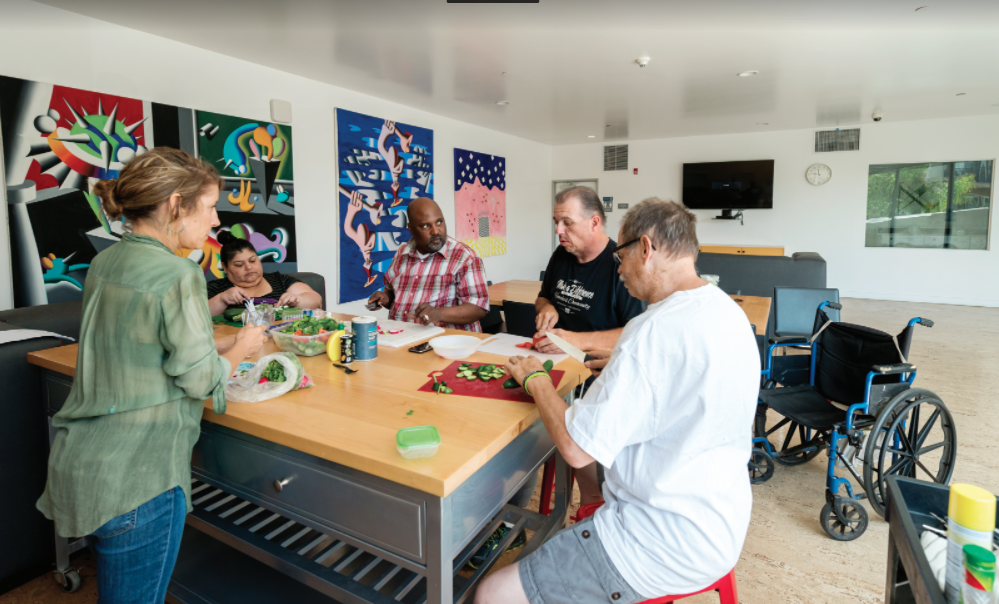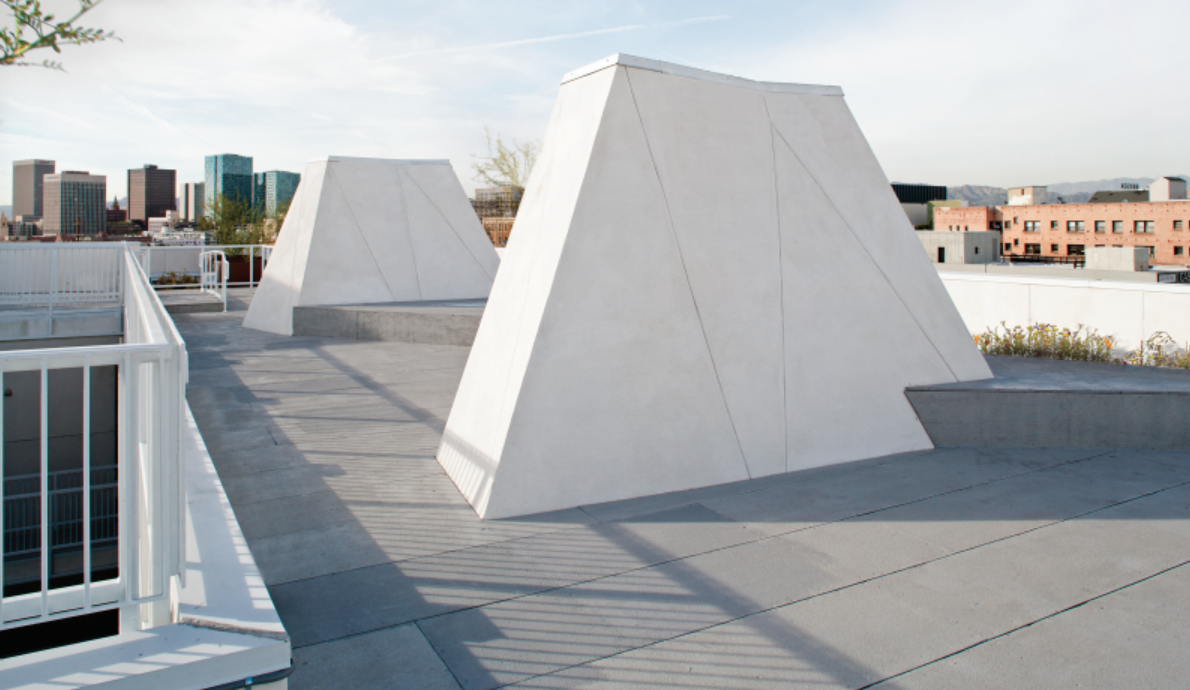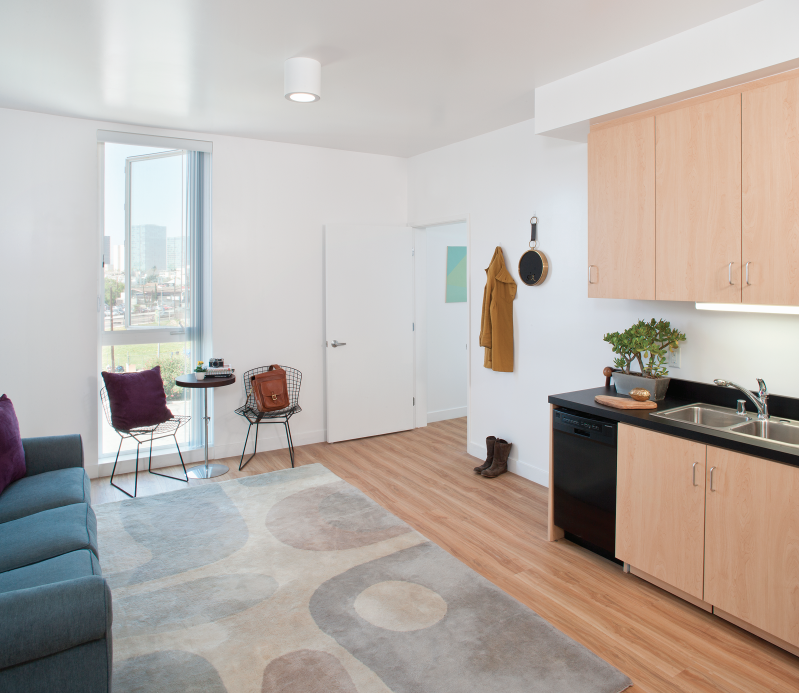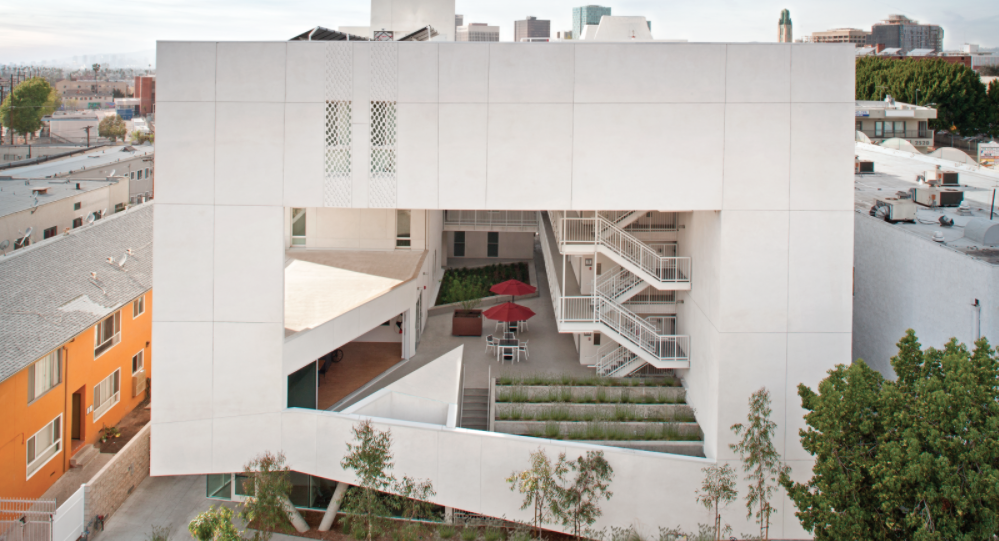For the homeless, the experience of obtaining social services, whether in a soup kitchen, shelter, or free clinic, often means having to encounter institutional buildings marked by dingy walls, stained floors, and annoying fluorescent lights.
“The message people get is, ‘We don’t really care very much about you,’” says Mike Alvidrez, CEO, Skid Row Housing Trust, Los Angeles. “We don’t see that as a healthy way to change one’s life.”
Alvidrez says it’s almost impossible for people to overcome mental, social, and medical problems while they’re homeless. Skid Row Housing Trust’s approach is to provide housing first, so that problems emanating from prolonged poverty, poor health, disabilities, mental illness, or addiction can be addressed, and people can go on to lead “safe, stable lives in wellness.”
To fulfill that mission, Skid Row Housing Trust works with award-winning architects to create masterfully designed “supportive” apartment buildings. “We want these buildings to feel inspirational and aspirational, so residents feel proud of where they live and aspire to do more,” says Alvidrez.
That philosophy certainly applies to The Six, an 18,390-sf building designed by Los Angeles–based Brooks + Scarpa. The Six provides 52 apartments and studio efficiencies for formerly homeless individuals; 18 of the units have been set aside for veterans. The name comes from the military expression “Got your six,” meaning “I’ve got your back.”
DESIGNING A PLACE FOR HEALING
The Six is located at 811 South Carondelet Street in MacArthur Park, one of the highest-density neighborhoods in the U. S.—38,000 per square mile. The architects were aware that successful recovery and rehabilitation for Skid Row Housing’s clients depended on the ability of formerly homeless individuals to be reintroduced into society.
The design of The Six purposely deemphasizes personal space in favor of community space where residents can make connections organically—to others, and to their surroundings.
“Projects like this tend to become very large compact masses, and light and ventilation become real problems,” says Lawrence Scarpa, FAIA, LEED AP, CEO, Brooks + Scarpa. “We wanted the units to be open and light-filled, with good cross-ventilation, and still have privacy for tenants.”

The view from the second-floor podium courtyard into the community room. “For the veterans and other tenants who are suffering from schizophrenia and other problems, the courtyard and community room get them to be among other people,” says Lead Designer Larry Scarpa, FAIA. Photo: Tara Wujcik
The solution was to create a huge five-story white cube with massive holes punched into three sides. Skid Row Housing’s Alvidrez admits that The Six really stands out. “Let’s face it, it’s a box, but, man, what a box!” he says. “The opening in the front is what you notice first: ‘Hey, there’s a big hole in that building. What the hell is that about?’ It sets up a conversation with the community. Homelessness is something we need to talk about. The solution needs to be loud and proud.”
The varying size of the punched holes induces cross-ventilation that takes advantage of the local climate and prevailing breezes. “The air really flows through,” says Brooks + Scarpa Design/Project Manager Diane Thepkhounphithack. The units have huge casement windows that catch the wind. Transom windows over the entry doors allow air and light to penetrate the living spaces.
The emphasis on natural light and airflow reinforces the designers’ focus on promoting physical and emotional healing. “With any form of recovery, being exposed to light, ventilation, and beautiful weather can make a huge difference,” Thepkhounphithack says.
GIVING TENANTS MEANINGFUL OPTIONS
To encourage residents to get out and about instead of hunkering in their rooms, the 45 studio efficiencies (350 sf) and seven one-bedroom units (500 sf) provide just enough room for a bed, bathroom, and small kitchen. Rents are based on income.
The organic nature of the pierced walls opens up an extensive courtyard on the second floor that connects to a community space with sliding glass doors (which are usually kept open during the day). This nexus between the courtyard and the community space can, depending on the needs of the tenant, provide opportunity either for involvement with others, or for privacy.
“Our task was to allow people to interact with others, but at their own choosing,” says Scarpa. “The community room is wide open and connects to the courtyard, so people can interact but still be part of the bigger space.”
The open frame of the building gives residents a feeling of privacy despite the intense density of the neighborhood. “As soon as you put a frame around something, you feel a sense of separation, in a good way,” says Thepkhounphithack. “When you’re on the podium deck, technically you’re exposed because people can see in, but you feel pulled back, and you still have a sense of privacy.”

James Grahn, 53 (right, with residents Tony Hill and Robert Odom), served in the Army Signal Corps in Germany, Texas, and California (1982 to 1991), then did a stint in the National Guard (2001 to 2011). “I had a lot of fun in the army,” he says. Before moving to The Six in May, Grahn lived in a friend’s RV, then wound up in a VA hospital. His last stop was a homeless shelter in downtown LA.
Pathways through the building lead to the staircase that connects to the residential units on the upper floors of the five-story structure. That wayfinding pattern was carefully choreographed.
“It’s not the most efficient way to get around,” says Thepkhounphithack. “The pathways are meant to be meandering, to encourage residents to get outside in communal spaces in order to socialize and reconnect with the community.”
Diana Pescar, Resident Services Coordinator with Skid Row Housing , says she’s pleasantly surprised at how well the community space is working. “They’re playing dominoes out there on the picnic tables, stuff you’d see on Skid Row, but now they’re in this safe environment.”
PROVIDING SORELY NEEDED SERVICES
As with all Skid Row Housing projects, The Six has on-site supportive services: primary medical and mental healthcare, individual and group counseling, health and dental screenings, addiction recovery support, and assistance with obtaining government entitlements.
Three case managers—Pescar, Daniel Myatt, and Shanknika Ainsworth—provide intensive case management for all residents, including peer-group counseling, crisis intervention, and hands-on help with applications for Social Security disability and veterans’ benefits. “Because they’ve been homeless, our residents often don’t have their birth certificates or discharge papers,” says Pescar. “We have a direct line to the VA and can get those documents.”
To foster interaction among the residents, the case managers offer classes in improv acting, music appreciation, cooking on a budget, and flower arrangement. Pescar, who has a degree in art education, says she initially got a lot of grief about the flower class. “Oh, the guys’ll never come! That’s all I heard.” But the class is full every week. “That class has taught me that these men have interests that you wouldn’t think possible—aesthetics, gardening, music,” says Pescar.
NO SHORTAGE OF PROBLEMS TO SOLVE
The Six’s team faced more than its fair share of hurdles. The design was well under way when the project had to be moved to a new site. “We had to scramble to produce a quick concept design to show lenders the project was still viable,” says Thepkhounphithack.
The complicated funding package created another set of problems. Skid Row Housing Trust pulled together $10.1 million from a wide array of sources: National Equity Fund, Los Angeles Housing + Community Investment Department, Housing Authority of the City of Los Angeles, Los Angeles County Department of Health Services, California Tax Credit Allocation Committee, Local Initiatives Support Corp., Federal Home Loan Bank of San Francisco, Charles Schwab Bank, Century Housing Corp., and Wells Fargo.

Mechanical systems are enclosed in decorative sculptural forms. “We worked hard to consolidate hundreds of shafts and exhausts so that our roof wouldn’t become a big mechanical zone,” says Larry Scarpa. Photo: Tara Wujcik
The lenders imposed strict—and immovable—timelines on the team. “If you miss the timeline, they revoke your funding. No fees or fines, they just take your money back,” Thepkhounphithack says. It was a constant race against the clock. Very late in the construction schedule, they discovered a misunderstanding about one lender’s deadline. “We had to finish one or two months earlier than scheduled,” she says. The general conrtractor, Golden Bear Construction, had to frame entire floors in a week.
Permitting also proved a headache. Some of the newer materials the team wanted to use, while not that unusual—for example, a new wood composite screen material—the building department wouldn’t allow because its research department hadn’t tested it.
“What’s good enough for every other building department in the world is not good enough for LA,” says Scarpa. Says Thepkhounphithack, “It was an intense process. We basically lived in the building department.”
MAKING A BOLD STATEMENT
The architectural style of The Six was clearly intended to stand out. Thepkhounphithack says the design of the building was about “propelling the neighborhood forward,” rather than just blending in.
The all-white façade of the five-story structure brings a brightness and tranquility to the building and provides a background to the landscaping (by LandStudio 360 and Brooks + Scarpa). The grass in the planters is bright pink when in bloom; the roof plants are red hot pokers. The stark façade provides a dramatic backsplash to these piercing colors as they come into season and change with time, she says.
In addition to earning LEED for Homes Platinum certification, The Six has already captured a slew of prizes: 2017 National AIA Institute Honor, AIA National Housing Award, AIA California Council Honor Award, AIALA Honor Award, and AIA Sustainability Honor Award.

Luxury sheet vinyl flooring helps keep maintenance under control at The Six. Walls were done in semi-gloss paint (level-four smooth finish) for easy cleaning. Units are ADA-adaptable, with zero-step thresholds and roll-in showers or tubs. Photo: Tara Wujcik
For the project team, the true reward has come in how The Six is helping provide elegant housing at affordable rates to those who were previously on the street. This is especially true for the veterans. Says Thepkhounphithack, “It’s good to have them be part of the future instead of being stuck in the past.”
The biggest benefit for the veterans and other formerly homeless residents, says Skid Row Housing Trust’s Diana Pescar, is that The Six induces “a sense of pride about being deserving of living in a nice place.” Her boss, Mike Alvidrez, puts it this way: “We want them to feel proud that this is their home, their community.”
PROJECT TEAM | THE SIX, LOS ANGELES
CLIENT Skid Row Housing Trust, LLC ARCHITECT Brooks + Scarpa STRUCTURAL ENGINEER John Martin & Associates CIVIL ENGINEER Barbara L. Hall, PE MEP ENGINEER Innovative Engineering Group SPECIFICATIONS Phil Easton LANDSCAPE ARCHITECT Brooks + Scarpa; LandStudio 360 GENERAL CONTRACTOR Golden Bear Construction
Related Stories
Urban Planning | Jun 15, 2023
Arizona limits housing projects in Phoenix area over groundwater supply concerns
Arizona will no longer grant certifications for new residential developments in Phoenix, it’s largest city, due to concerns over groundwater supply. The announcement indicates that the Phoenix area, currently the nation’s fastest-growing region in terms of population growth, will not be able to sustain its rapid growth because of limited freshwater resources.
Multifamily Housing | Jun 15, 2023
Alliance of Pittsburgh building owners slashes carbon emissions by 45%
The Pittsburgh 2030 District, an alliance of property owners in the Pittsburgh area, says that it has reduced carbon emissions by 44.8% below baseline. Begun in 2012 under the guidance of the Green Building Alliance (GBA), the Pittsburgh 2030 District encompasses more than 86 million sf of space within 556 buildings.
Industry Research | Jun 15, 2023
Exurbs and emerging suburbs having fastest population growth, says Cushman & Wakefield
Recently released county and metro-level population growth data by the U.S. Census Bureau shows that the fastest growing areas are found in exurbs and emerging suburbs.
Engineers | Jun 14, 2023
The high cost of low maintenance
Walter P Moore’s Javier Balma, PhD, PE, SE, and Webb Wright, PE, identify the primary causes of engineering failures, define proactive versus reactive maintenance, recognize the reasons for deferred maintenance, and identify the financial and safety risks related to deferred maintenance.
Mixed-Use | Jun 12, 2023
Goettsch Partners completes its largest China project to date: a mixed-used, five-tower complex
Chicago-based global architecture firm Goettsch Partners (GP) recently announced the completion of its largest project in China to date: the China Resources Qianhai Center, a mixed-use complex in the Qianhai district of Shenzhen. Developed by CR Land, the project includes five towers totaling almost 472,000 square meters (4.6 million sf).
Mixed-Use | Jun 6, 2023
Public-private partnerships crucial to central business district revitalization
Central Business Districts are under pressure to keep themselves relevant as they face competition from new, vibrant mixed-use neighborhoods emerging across the world’s largest cities.
Multifamily Housing | Jun 6, 2023
Minnesota expected to adopt building code that would cut energy use by 80%
Minnesota Gov. Tim Walz is expected to soon sign a bill that would change the state’s commercial building code so that new structures would use 80% less energy when compared to a 2004 baseline standard. The legislation aims for full implementation of the new code by 2036.
Student Housing | Jun 5, 2023
The power of student engagement: How on-campus student housing can increase enrollment
Studies have confirmed that students are more likely to graduate when they live on campus, particularly when the on-campus experience encourages student learning and engagement, writes Design Collaborative's Nathan Woods, AIA.
Multifamily Housing | Jun 1, 2023
Income-based electric bills spark debate on whether they would harm or hurt EV and heat pump adoption
Starting in 2024, the electric bills of most Californians could be based not only on how much power they use, but also on how much money they make. Those who have higher incomes would pay more; those with lower incomes would see their electric bills decline - a concept known as income-based electric bills.
Multifamily Housing | May 30, 2023
Boston’s new stretch code requires new multifamily structures to meet Passive House building requirements
Phius certifications are expected to become more common as states and cities boost green building standards. The City of Boston recently adopted Massachusetts’s so-called opt-in building code, a set of sustainability standards that goes beyond the standard state code.

















